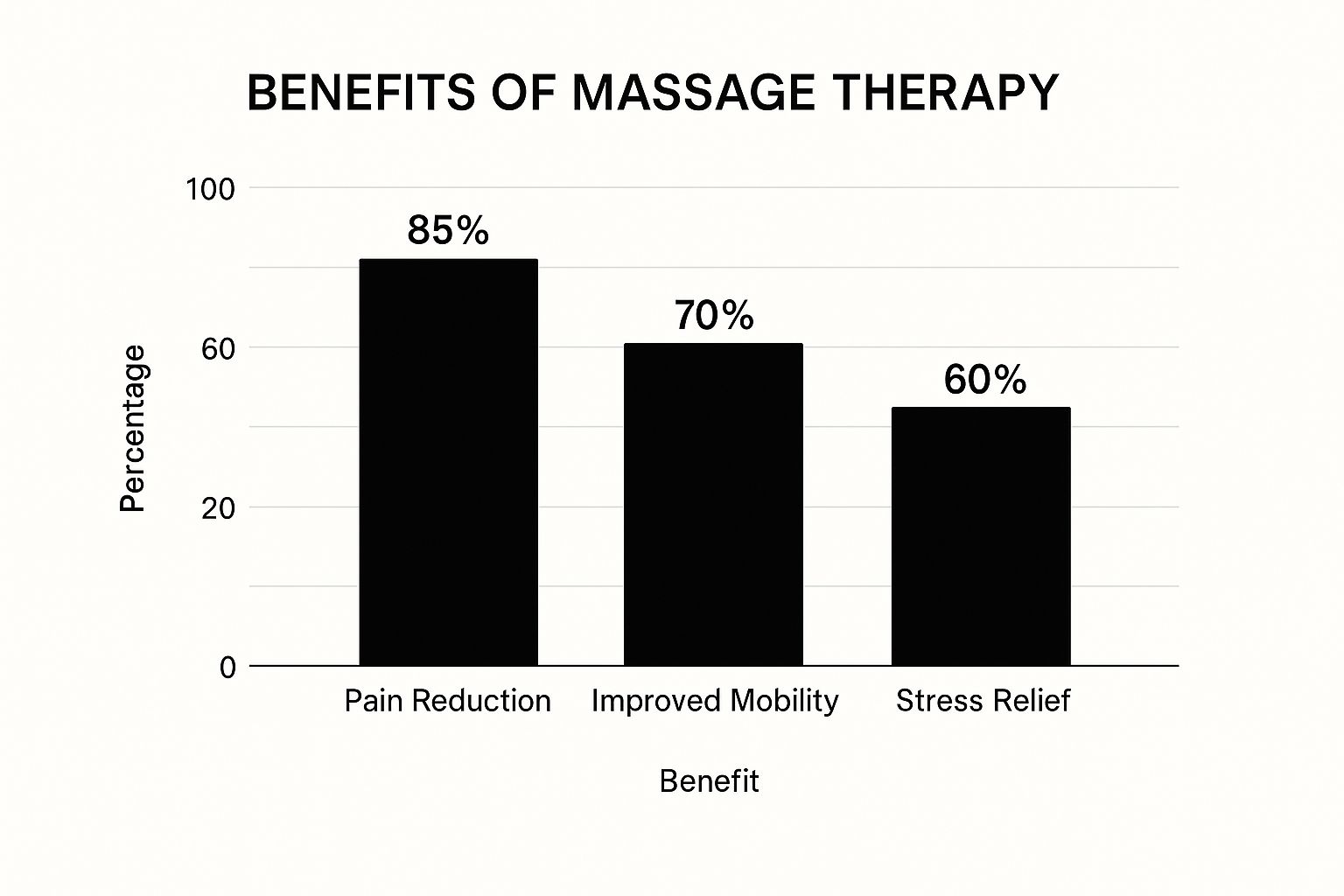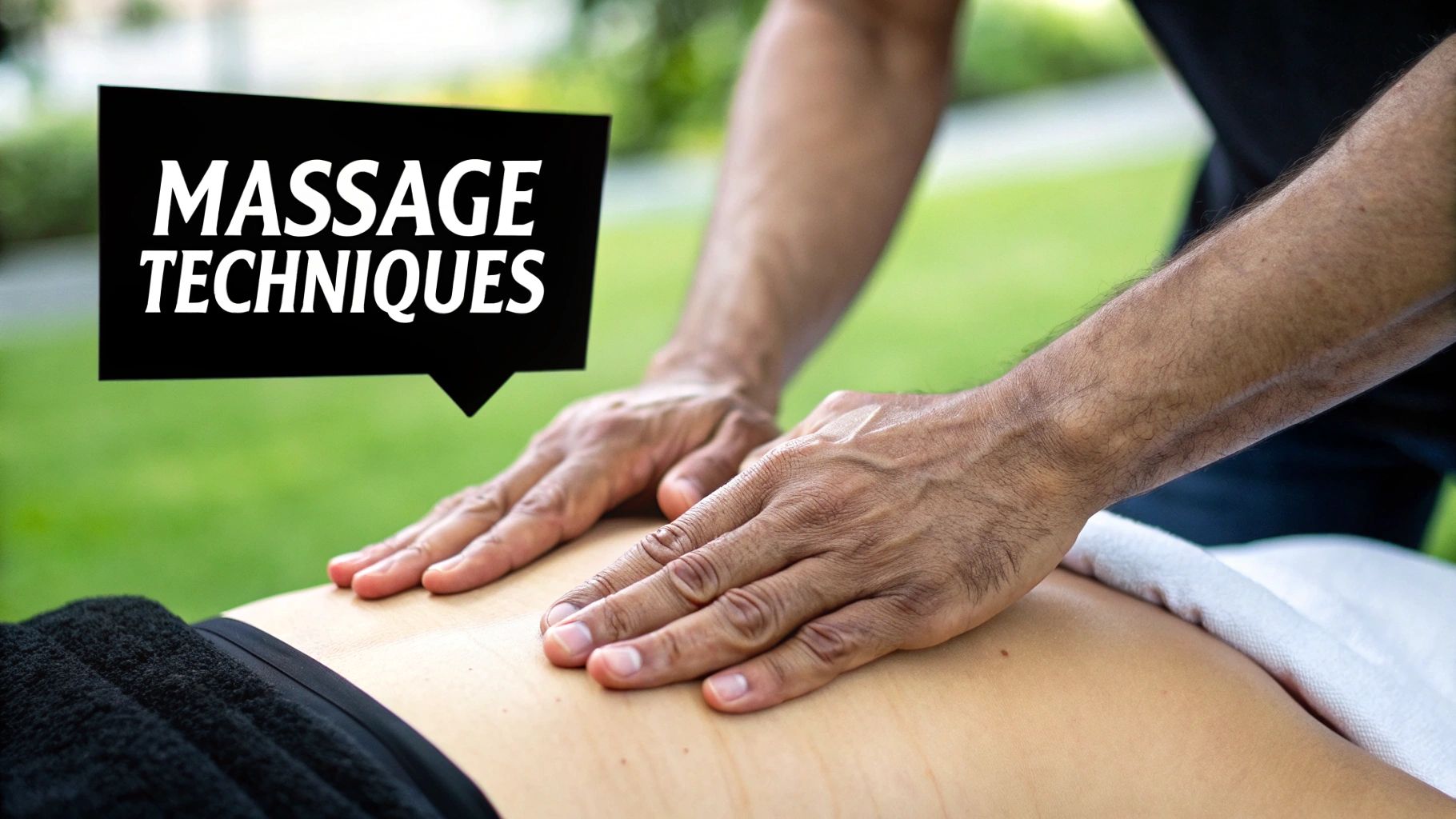Back Pain Massage Therapy: Effective Natural Relief Tips

Why Your Back Hurts and How Massage Actually Helps
That constant, nagging ache in your lower back can feel like a mystery, but there’s a clear story unfolding just beneath your skin. Picture your back's complex network of muscles, bones, and nerves as a finely tuned suspension bridge. Each muscle is like a high-tension cable, and when one becomes too tight from things like poor posture, overuse, or stress, it starts to pull the entire structure out of alignment. This imbalance is often where the trouble begins.
The most common culprits behind back pain are muscular strain and tension. When muscles are stuck in a state of contraction, they don't just feel sore. They can also squeeze the sensitive nerves running through and around them, which is what sends those sharp pain signals to your brain. This constant tension also chokes off blood flow, stopping essential oxygen and nutrients from reaching the tissues and preventing waste products from being cleared away. This creates a painful cycle of inflammation and soreness that can turn simple movements into a major challenge.
The Science of Soothing Touch
This is where back pain massage therapy comes in, not as a luxury, but as a targeted solution to a physical problem. A skilled therapist isn't just rubbing your back; they are working to release the overtightened "cables" of that metaphorical bridge. The specific pressure and movements of a professional massage accomplish several crucial things:
- Boosts Circulation: The kneading and gliding motions physically push blood through congested areas. This action floods the muscles with fresh, oxygen-rich blood that is vital for healing.
- Breaks the Pain Cycle: Therapeutic touch helps convince chronically tight muscle fibers to relax, breaking the painful spasm cycle and bringing back flexibility.
- Changes How Your Brain Perceives Pain: Massage stimulates sensory receptors in your skin and muscles. These new signals can actually interrupt and override the pain signals traveling to your brain. It also prompts the release of endorphins, which are your body's own natural painkillers.
More Than Just a Feeling
The impact of back pain on daily life and the economy is huge. It is a leading cause for missed workdays, and Americans spend more than $50 billion every year trying to find relief. Research backs up what many already know: massage therapy is a legitimate and effective tool for managing the low back pain that causes so much widespread disability. To learn more about specific techniques for relief, check out our detailed guide on pain relief massage therapy.
By getting to the root causes of muscle tension and inflammation, massage offers a real path toward lasting comfort. For a deeper look at the data, you can explore the findings from the American Massage Therapy Association.
The Research That Changes Everything About Back Pain

While the soothing feeling of a good massage is something you can feel right away, it's reasonable to wonder if it's just a fleeting pleasure or a genuine medical treatment. Science has started to view massage as more than just a luxury, recognizing it as a credible, evidence-based approach for chronic back pain. Solid studies now show what many have long suspected: therapeutic touch sets off real, measurable healing processes in the body. It’s not simply about feeling good for an hour; it's about kickstarting your body’s own recovery mechanisms.
The reason back pain massage therapy works so well is that it tackles pain from several angles at once. It isn't a single action but a combination of biological responses working together to bring relief and promote healing.
Unlocking Your Body's Natural Pharmacy
One of the most important effects of massage is its ability to stimulate the release of endorphins. You can think of endorphins as your body's personal pharmacy, creating powerful pain-relieving chemicals that can be more effective than some over-the-counter medications. When a therapist applies skilled, targeted pressure, it signals your brain to release these natural mood-boosters and pain fighters.
At the same time, massage therapy helps to lower cortisol, the body's main stress hormone. Chronic pain and high stress often go hand-in-hand, creating a feedback loop where each one worsens the other. By reducing cortisol, massage helps break this cycle, shifting your body out of a constant "fight-or-flight" state and into a "rest and repair" mode that is essential for long-term healing.
Backed by Real-World Data
The evidence isn't confined to a laboratory; it's also seen in large-scale studies that track how people's lives improve. A key study published in Pain Medicine provided strong support for using massage in a real-world clinical setting. Researchers followed people with chronic low back pain who received massages from therapists in their communities.
The outcomes were clear: over 50% of the participants reported clinically meaningful improvements in their pain and ability to perform daily activities. This kind of data elevates back pain massage therapy from a simple alternative to a validated treatment choice, proving it can deliver tangible results. You can find more details about this research in the KYPROS study and its findings on pain medicine.
This growing body of research confirms that choosing massage is a scientifically supported decision for managing back pain. It’s a proactive way to get back your comfort and mobility, backed by clear evidence of its biological effects.
Finding Your Perfect Massage Match for Back Pain Relief
Choosing the right kind of back pain massage therapy is like picking the perfect tool for a home repair project—you wouldn't use a hammer when you need a screwdriver. Not every massage technique is the same, and the best one for you hinges entirely on the nature of your pain. Your body tells you what it needs through the specific discomfort you feel, and learning to read those signals is the first step toward finding real relief.
Matching the Technique to Your Pain
Think of your pain as a roadmap. A general, widespread ache that feels tied to stress and fatigue often responds wonderfully to Swedish massage. This classic technique relies on long, flowing strokes to encourage relaxation and boost circulation, gently easing tense muscles without aggressive pressure. It's a great choice if you're new to massage or dealing with broad, low-level discomfort.
On the other hand, if your pain is deep, stubborn, and located in specific spots—those hard, persistent knots that just won't budge—you'll need a more focused approach. Deep tissue massage is designed precisely for this, using slower, more forceful strokes to break down adhesions in the deeper layers of muscle and connective tissue. For those sharp, "bullseye" points of pain that sometimes send discomfort to other parts of your body, trigger point therapy works like a precision instrument, applying direct pressure to release the knot and soothe the irritated nerve.
To help you choose the right massage for your back pain, here's a table comparing some of the most effective techniques.
Table: Massage Techniques for Different Types of Back Pain
Description: Comparison of massage techniques, their benefits, and which back pain conditions they work best for.
| Technique | Best For | Pain Relief Level | Session Duration |
|---|---|---|---|
| Swedish Massage | General tension, stress-related aches, mild soreness | Mild to Moderate | 60-90 minutes |
| Deep Tissue Massage | Chronic muscle pain, knots (adhesions), limited mobility | Moderate to Intense | 60-90 minutes |
| Trigger Point Therapy | "Knots" that refer pain elsewhere, sciatica-like symptoms | Intense, Targeted | 30-60 minutes |
| Sports Massage | Injury prevention, muscle strain from overuse, post-activity recovery | Moderate to Intense | 60-90 minutes |
This table shows how different methods target specific issues, from the relaxing, broad strokes of Swedish massage to the focused intensity of trigger point therapy. The key is to match the technique to your symptoms for the best outcome.
The chart below visualizes the primary reasons people seek massage therapy for their back pain.

This data highlights a clear trend: while stress relief is a welcome side effect, an overwhelming 85% of individuals seek massage primarily for direct pain reduction. Improved mobility is another significant goal.
The Power of a Combined Approach
A truly effective massage therapist rarely uses just one technique. Instead, they act like a skilled mechanic, blending different methods in a single session to address your body's unique map of pain. For example, a session might begin with gentle Swedish strokes to warm up the muscles before moving to deep tissue work on a trouble spot in your lower back. This combined strategy prepares your body for more intensive work, leading to better results and a more comfortable and effective session overall. Knowing these options allows you to have a meaningful conversation with your therapist, helping you work together to create a treatment plan that truly addresses the root of your back pain.
Your First Session: What Really Happens Behind Closed Doors

Walking into a massage room for the first time can feel a bit mysterious, but knowing what to expect can turn any apprehension into anticipation. A session for back pain massage therapy is more than just relaxation; it's a structured process designed to understand and relieve your specific discomfort. This experience starts well before any massage oil is even uncapped.
The Initial Conversation: Solving the Pain Puzzle
The first few minutes of your session are critical. Think of your therapist as a detective, asking focused questions to get to the root of your back pain. Where exactly does it hurt? What does the pain feel like—is it a dull ache, a sharp sting, or does it radiate elsewhere? What daily activities seem to make it flare up?
This initial chat is your time to share the full story of your pain. The more honest and detailed you are, the better. This information helps your therapist create a mental map of your muscles and choose the most effective techniques for you. After the discussion, they will leave the room, giving you privacy to undress to your comfort level and get settled under the sheet on the massage table.
During the Massage: Reading Your Body's Story
Once the hands-on work starts, your therapist is doing much more than following a script. They are reading your body's story through touch, identifying tight spots, inflammation, and knots you might not even know you had. Throughout this process, communication is a two-way street.
- Pressure is a dialogue: Your therapist will likely check in about the pressure they're using, but you should always feel empowered to speak up. A simple 1-to-10 scale can be a helpful way to communicate what feels right.
- "Good pain" vs. "bad pain": When a therapist works on a stubborn knot, you might feel an intense sensation often called "good pain." This is a productive feeling of release. However, if you feel any sharp, shooting, or unbearable pain, that’s a signal to stop. Never hesitate to say if something hurts too much.
- Breathing is your tool: As your therapist focuses on a tender area, concentrate on taking slow, deep breaths. This simple action helps your muscles relax and let go, making the treatment much more effective.
After the Session: The First Step in Recovery
When the massage is over, your therapist will give you a moment to get up slowly, as you might feel deeply relaxed or a little light-headed. They will almost certainly recommend drinking plenty of water. This helps your body flush out the metabolic waste that was released from your muscles during the session.
It's also perfectly normal to feel some soreness for a day or two afterward, similar to how you might feel after a good workout. This is called Delayed Onset Muscle Soreness (DOMS), and it's a sign that your muscles were worked effectively. You can ease this temporary discomfort with some gentle stretching or a warm bath.
Real People, Real Results: The Numbers Don't Lie
Inspiring success stories from people who found relief through **back pain massage therapy** are powerful, but the clinical data paints an even clearer picture. While personal testimonials offer hope, rigorous scientific studies provide the proof that this approach delivers real, measurable outcomes. This research helps us understand not just *if* massage works, but *how well* it works compared to other treatments.
Setting Expectations for Relief
Knowing what level of improvement you can realistically expect is an important part of any healing process. Some people feel a dramatic difference after a single session, but for most, consistent therapy brings the most significant and lasting results. Your personal timeline for improvement will depend on a few key factors:
- The chronicity of your pain: Pain that has been around for years (chronic) may take more sessions to address than a recent, acute muscle strain.
- The underlying cause: Discomfort from simple muscle tension often resolves more quickly than pain connected to long-standing postural issues or old injuries.
- Your consistency: Following a recommended treatment plan is essential for building on the progress you make in each appointment.
Think of it like this: the benefits of deep tissue massage build on each other over time, as each session works to release deeper layers of knotted muscle tissue. You can learn more about this powerful technique in our guide on deep tissue massage.
How Massage Stacks Up
When put to the test in a clinical setting, a structured massage therapy plan has shown impressive results. One significant clinical trial looked at how different hands-on therapies performed for subacute low back pain. The findings were compelling: at the one-month follow-up, an incredible 63% of patients who received a comprehensive massage therapy plan reported being completely free of pain.
This result was substantially better than the 27% who reported the same outcome from a less intensive soft-tissue manipulation group. This data shows that a dedicated massage therapy plan can provide a distinct advantage for achieving true recovery. You can read the full research about these back pain findings to see the detailed comparison.
Choosing a Therapist Who Actually Gets Back Pain

The success of your back pain massage therapy is almost completely dependent on the skill and knowledge of the person providing the treatment. Finding the right therapist isn't a matter of chance; it's about knowing what signals genuine expertise. You wouldn't hire a general contractor to fix a complex electrical problem, and similarly, you shouldn't entrust chronic back pain to a therapist without specialized training. The difference between a decent massage and a great one lies in a deep understanding of the body's mechanics and direct experience with conditions like yours.
Credentials That Signal Expertise
A state license is just the starting point—it's the bare minimum requirement to practice. For targeted, effective back pain relief, you need to find therapists who have pursued education well beyond the basics. These professionals have invested significant time to become specialists, not just generalists. Think of it this way: plenty of people can follow a recipe, but a true chef understands the science behind how flavors combine and react. A specialist therapist understands the science of pain, muscle function, and recovery.
When you're searching for a therapist, look for these indicators of advanced training:
- Medical Massage Practitioner (MMP): This certification shows a therapist has advanced training in outcome-based massage. They are skilled at working with specific medical conditions and developing treatment plans.
- Neuromuscular Therapy (NMT): Therapists with NMT certification are experts at locating and releasing trigger points—those tight, painful knots in muscles. They also address nerve compression issues that are a common source of radiating back pain.
- Myofascial Release Specialization: This signals expertise in treating the body's connective tissue, or fascia. When fascia becomes tight and restricted, it can cause widespread pain and limit movement.
- Experience with Specific Conditions: A therapist who regularly helps clients with sciatica, herniated discs, or postural strain will have a more refined set of techniques. For example, understanding the difference between a sports injury and chronic tension from office work is critical. You can learn more about how a sports massage vs. a regular massage can address different needs in our detailed comparison.
Asking the Right Questions
Once you've found a therapist who looks promising on paper, the consultation is your chance to verify their expertise. Don't feel hesitant to ask direct questions; this is a critical step for your health and recovery. Thoughtful questions will quickly show whether a therapist truly understands your condition or is just offering a one-size-fits-all approach.
To help you assess a potential therapist, we've created a guide with key qualifications and questions. Use this to ensure you're choosing someone with the right background to address your specific back pain.
| Therapist Qualifications and Specializations Guide |
| :— | :— | :— | :— |
| Qualification | Importance Level | What It Means | Questions to Ask |
| State Licensure | Essential | The therapist meets the legal minimum standard to practice in your area. | "Are you currently licensed in this state?" |
| Advanced Certifications (MMP, NMT, etc.) | High | They have pursued specialized training for complex conditions beyond basic massage school. | "What advanced certifications do you hold that are relevant to back pain?" |
| Experience with Your Specific Condition | High | They have a proven track record of successfully treating issues similar to yours (e.g., sciatica, disc issues). | "What is your experience treating clients with [your specific condition]?" |
| Clear Treatment Philosophy | Medium | They have a logical approach to how they assess and treat pain, not just a random assortment of techniques. | "What techniques do you find most effective for this type of pain, and why?" |
| Progress Tracking | Medium | They use objective measures to track your improvement, not just subjective feelings. | "How will we determine a treatment plan and measure my progress over time?" |
This table helps you go into a consultation prepared to identify a truly qualified professional.
Finding the right hands to help heal your back is the single most important decision in your recovery journey. A qualified, experienced, and specialized therapist offers more than temporary relief—they provide a clear, strategic path toward lasting wellness.
Making Every Session Count: Your Success Strategy
Getting fantastic results from back pain massage therapy isn't just about what happens on the table—it's about actively partnering in your own recovery. Think of your therapy as a team effort where you and your therapist work together. This teamwork starts before you even arrive for your appointment and continues long after you leave, and it's what truly boosts your progress.
Prime Your Body for Deeper Healing
Preparing for your session helps your therapist work more effectively and allows your body to get the most out of the treatment. It's like warming up before a workout; it makes your muscles more receptive to the work ahead.
- Hydrate Well: Drink plenty of water in the 24 hours before your massage. Well-hydrated muscles are more pliable, which helps the therapist work deeper and can reduce post-session soreness.
- Gentle Movement: A light walk or some simple stretches before your session can increase blood flow to tight areas. This gentle warm-up signals to your muscles that it's time to relax.
- Arrive Calm: Rushing to your appointment can make you feel tense and flustered. Plan to arrive a few minutes early so you can sit quietly and take a few deep breaths, helping shift your body into a more relaxed state.
Extend Your Results for Days, Not Hours
The hour after your massage is just as important as the hour on the table. Your actions in the 24-48 hours that follow can either lock in your progress or accidentally undo the therapist's hard work. To keep feeling great, here's what to do:
- Rehydrate Immediately: Continue drinking water to help your body flush out the metabolic waste that was released from your muscles during the session.
- Take a Warm Bath: Soaking in an Epsom salt bath can be a game-changer. The magnesium in the salts helps soothe muscles and minimize any lingering soreness. This occasional soreness is a normal response, sometimes called Delayed Onset Muscle Soreness (DOMS).
- Avoid Strenuous Activity: Give your body time to adjust to its new, more relaxed state. Steer clear of heavy lifting or intense exercise for at least a day to prevent re-straining the muscles that were just released.
Building a Sustainable Long-Term Plan
Lasting relief from back pain is built on consistency and making smart choices between your massage sessions. Simple stretches that target your specific problem areas can make a huge difference—your therapist can show you the best ones for your body. Also, pay attention to your daily posture and workspace setup, as these are often the root causes of chronic back pain. Small adjustments to how you sit, stand, and lift can prevent pain from returning.
By taking an active role in your treatment, you turn each massage from a temporary fix into a meaningful step toward long-term wellness.
Ready to take control of your back pain? At La Moon Massage and Facial, our expert therapists are ready to partner with you on your path to recovery. Book your personalized session today and feel the difference.
